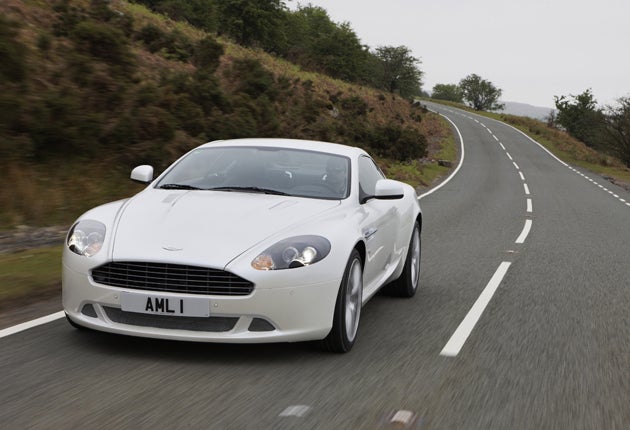Aston Martin Rapide Saloon
Six years on, and they've finally got the DB9 right

Aston Martin's new Rapide saloon is a luscious-looking machine.
It's as pleasing to drive as it is to gaze upon, and the fact that it can be a saloon while still looking obviously Aston Martin-like is an impressive feat of visual trickery.
It is, effectively, a lengthened, four-door Aston Martin DB9. In the same way, the V8 Vantage is effectively a shorter DB9. The DBS is a DB9 with attitude. Among all this derivation, how is the DB9 itself faring, six years after its launch?
I've had an unsatisfactory relationship with this car over the years. On the original launch I thought it was marvellous, exactly the sort of handsome, sophisticated, exhilarating, satisfying grand tourer that Aston Martin should be making and, at the time, probably better than its Italian rivals. Strange, then, that each subsequent DB9 I drove was worse than the one before. The next one had a Sport pack, which destroyed the ride comfort. The one after, in standard specification, just felt oddly "wooden" in its responses. I was deeply disappointed.
The launch cars, it later turned out, were using adjustable "development" suspension dampers set to match those due to be used in the production cars that customers would buy. But they didn't match; they were better. Whether or not the production cars did eventually reach the launch cars' standard I don't know, but it doesn't matter any more. That's because the DB9 has just had a makeover, with various cosmetic and equipment updates but also, more significantly, suspension with a new adaptive damper system.
First used in the DBS and then in the Rapide, it's a Bilstein system with Normal and Sport modes, each of which has a range of five stages of firmness which are automatically selected according to the forces acting on the DB9. Sounds simple; the tricky part is programming the settings to suit the car and the roads on which it will be driven, a trick not learnt in the first DBS I drove which floated strangely in Normal and appeared to be locked solid in Sport. The Rapide, by contrast, feels great.
And the DB9? Before finding out, a quick look at what else is new. The lower part of the nose has racier-looking air intakes. The side sills have a more pronounced kick-up aft of the doors, and the rear lights have clear instead of red lenses. Inside, the main change is a Bang & Olufsen stereo in place of the Linn unit originally fitted.
The DB9's engine is a 6.0-litre V12 with 477bhp on tap. It is linked rigidly to the rear-mounted gearbox by an aluminium tube inside which turns the carbonfibre propeller shaft. This is a car of hi-tech materials. The structure is of cast and extruded aluminium, and most of the body panels are either aluminium or composite plastic. The DB9, from £122,445, is beautifully made, and no trim material in the cabin attempts to look like something it is not.
Manual or automatic transmissions are offered. Most buyers opt for the "Touchtronic 2" auto with manual paddleshifts on the steering column. So, in with the glass-encased "key", press to start, hear that lovely V12 awaken. Suspension in Normal, transmission in its own Sport mode to sharpen the response and liberate a bit more of the engine's crisp bark.
Straight away this is a much nicer DB9. It now matches the Rapide for steering positivity and flows over bumps as well as ... as well as those launch cars, if I can remember accurately enough. Vitally, it continues to do so even on poor surfaces, although the shallow sidewalls of the tyres ultimately let the sharpest edges through. This is how the DB9 should always have been.
So I grit my teeth and set the suspension's Sport mode. The sinews tauten a lot, but not to the extent of rendering the suspension redundant. On anything other than a smooth road the ride becomes very fidgety, but at least you can escape from it when you've had enough. The former Sport pack option has been deleted, as you would expect.
The engine is as magnificent as ever, the gearbox shifts quickly, positively and smoothly, and the DB9's style still seems ageless. It has taken rather too long, but the DB9 is finally the car it promised to be.
The Rivals
Bentley Continental GT: £126,500
It's been around for a while, but this "affordable" Bentley coupé still looks dramatic. Four-wheel drive, 552bhp from a twin-turbo W12 engine.
Jaguar XKR: £75,500
A bargain in this company, the XKR uses a 5.0-litre supercharged V8 with 510bhp. Looks lovely, handles beautifully, sounds great. The logical choice.
Maserati GranTurismo S Automatic, £86,765
V8 engine, 434bhp, handsome looks, four usable seats. Feels a big car at first but soon shrinks around you.
Join our commenting forum
Join thought-provoking conversations, follow other Independent readers and see their replies
Comments